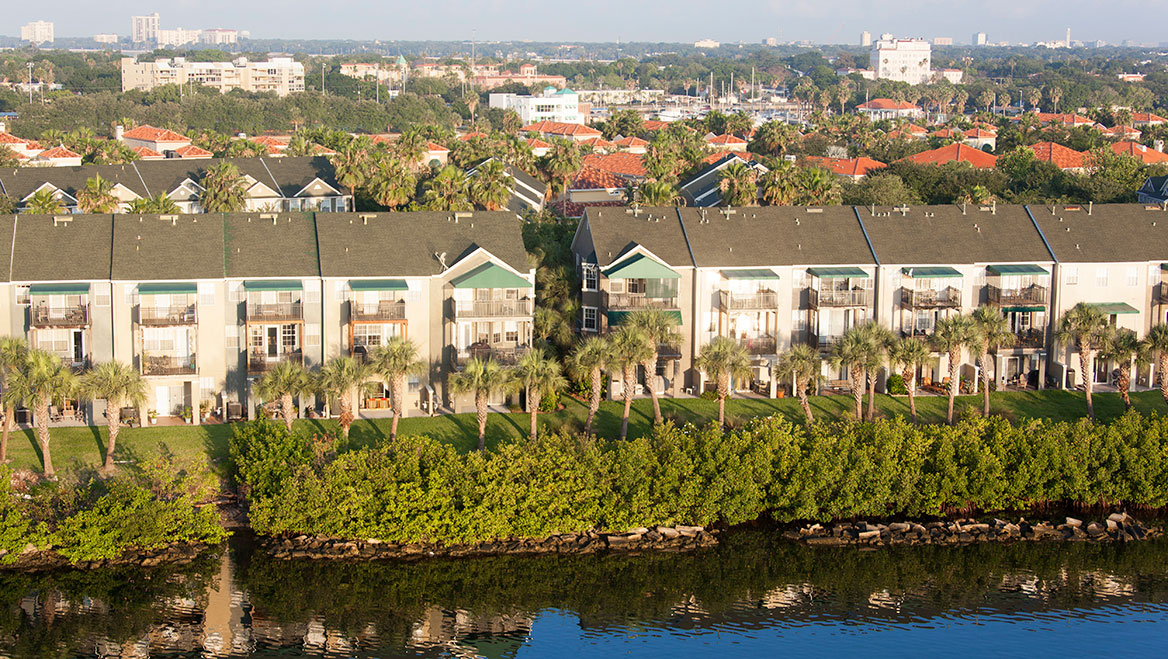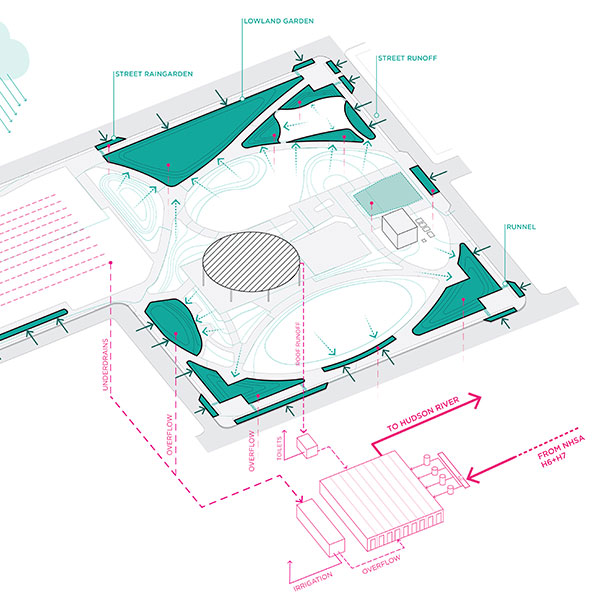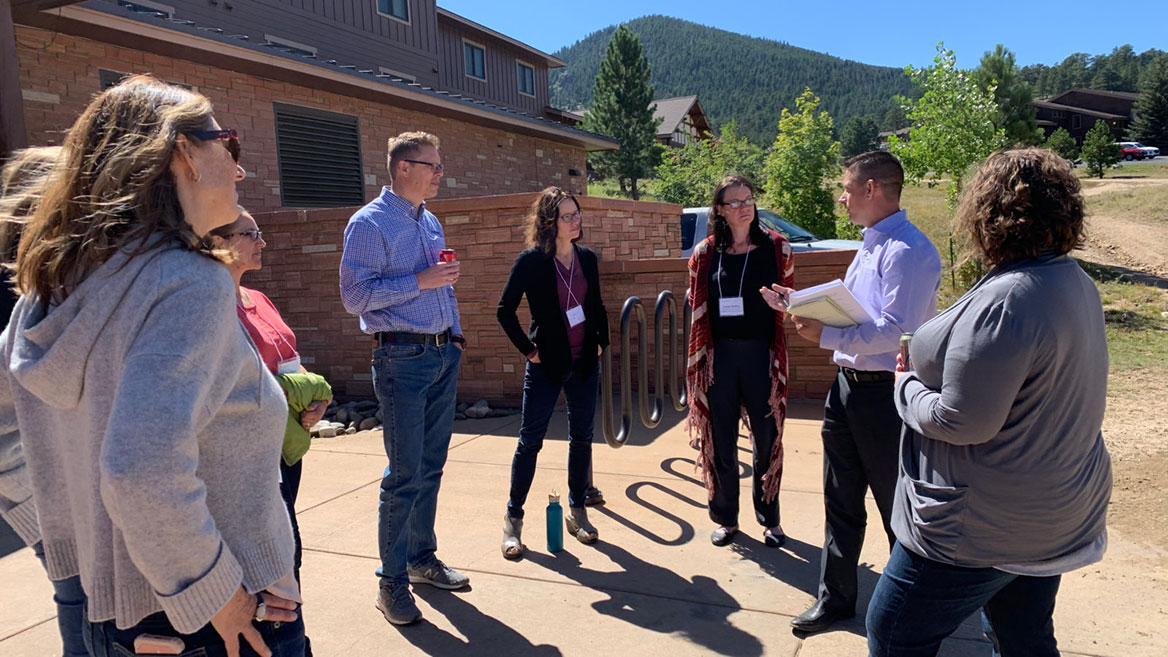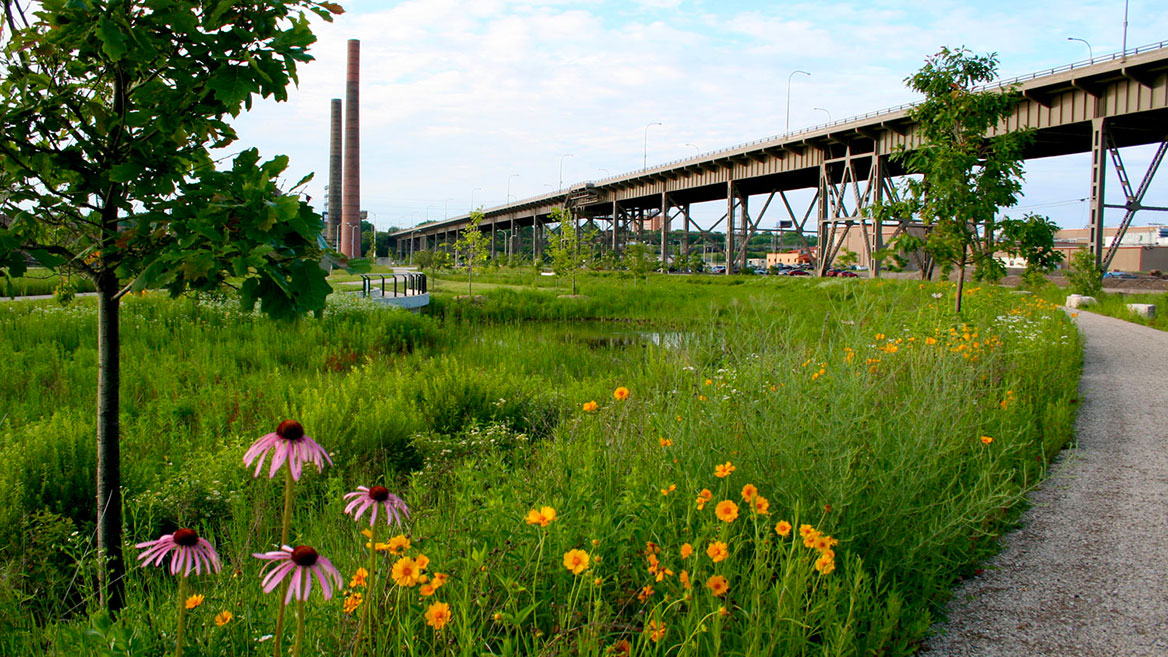July 1, 2021
Rick Schultz doesn't hate grass outright. He can see the use for it in some places — kids should be able to play soccer somewhere, sure — but there's no need for it in road medians or sweeping lawns in arid places, says Schultz, a water conservation specialist at the municipally owned utility in Castle Rock, Colorado.
Located on the southern fringes of the Denver metro area, Castle Rock is one of the fastest growing communities in the country. Its population has skyrocketed from 20,224 in 2000 to nearly 72,000 today. Seventy percent of Castle Rock's water supply comes from nonrenewable groundwater, so as the town grew, officials had to figure out how to stretch that supply. In 2006, the water utility and the planning department started collaborating to address that issue.
The water master plan set guidelines — like where it made sense to have grass — to delineate how and where the community could best conserve water while still accommodating growth. Schultz says they had to think outside of traditional land-use regulations and water supply patterns to work toward long-term sustainability, steering disparate parts of the planning process toward smart growth: "We needed to push the boundaries a little if we wanted a better outcome."
Since then, Castle Rock has introduced financial incentives, regulatory changes, and even behavioral science strategies to ensure that water supply is actively considered as part of every planning and development process. From offering incentives to developers who install water monitoring systems to requiring landscapers to pursue professional certification in water efficiency, Castle Rock has become a leader in this area, recognized by the state of Colorado for its efforts and for sharing best practices with other organizations.
In communities across the U.S., water managers and planners are emerging from the silos they've traditionally operated in to find new ways to work together. This is in part because climate change is causing turbulence in the water sector nationwide, in the form of prolonged droughts, damaging floods and wildfires, severe storms, and sea level rise. The urgency of developing resilience in the face of these threats is becoming increasingly clear. It's also because, although communities face many different challenges and operate with countless variations on municipal structures, many are rediscovering a singular truth about land and water: when you plan for one, you have to plan for both.
"Water engineers are beginning to recognize they cannot provide sustainable services without involving those in the development community — including planners, architects, and community activists," explains APA's Policy Guide on Water. "Leading edge planners are reaching across the aisle to water managers to help advise on their comprehensive plans, not only to meet environmental objectives, but also to add value and livability, rooted in the vision of the community."
How we got here
Picture the view from an airplane as you fly over rural areas or the outskirts of any major city: the way the right-angled boundaries of agricultural fields and housing plots contrast with the twisting braids of river channels and the irregular shape of lakes and ponds. Land and water are very different resources. They have been managed differently — and separately — as a result.
The divide between water and land planning has deep roots. Although water is connected to all parts of sustainable growth, from ecosystem health to economic viability, planners and water managers have long worked separately. From volunteer planning boards in rural communities to fully staffed departments in major cities, planners focus on land use and the built environment. Water managers, meanwhile, whether they are part of a municipally owned utility, private water company, or regional wholesaler, focus on providing a clean and adequate water supply.
"I can't think of a single city where [planning and water management] are contained within a single division," says Ray Quay, FAICP, a researcher at Arizona State University's Global Institute of Sustainability who has served as both assistant director of land planning and assistant director of water services in Phoenix, Arizona. Quay says regional and watershed-wide development choices about growth often don't line up with water supply.
"A typical divide would be that planners plan for growth while assuming the water utility will be able to supply water, while water utilities don't participate in decisions about community growth, they just build infrastructure to serve the new growth that comes to them," confirms Jim Holway, director of the Babbitt Center for Land and Water Policy, which was created by the Lincoln Institute of Land Policy in 2017 to advance the integration of land and water management.

The traditional divide between water and land planning means Florida's Tampa Bay Water utility can only provide water, not participate in decisions that affect the community's growth. Photo by virsuziglis/iStock/Getty Images Plus.
Ivana Kajtezovic, planning program manager at Tampa Bay Water, a regional wholesale drinking water utility in Florida, confirms that lack of alignment. "Tampa Bay Water doesn't have a say in growth in the counties and cities we serve," says Kajtezovic. "Our only mission is to provide drinking water, no matter the growth or the speed of growth. Land-use decisions are made by the counties and cities we serve."
In a 2016 APA Water Working Group Water Survey, 75 percent of land use planners felt they were not involved enough in water planning and decisions. "We know that land and water are connected, and no one ever argues that they're separate," says Phillip Stoker, assistant professor of planning at the University of Arizona, who conducted the APA survey. "It's only people who have separated them."
This divide is partly a result of historical regulatory structures. "Water is very much state law-based, with some federal hooks into various aspects of it," says Anne Castle, former Assistant Secretary for Water and Science at the U.S. Department of the Interior. Federal management involves regulations such as the Clean Water Act and agencies such as the U.S. Bureau of Reclamation, and water rights are allocated at the state level. Meanwhile, although there is federal and state oversight of some public lands, most of the regulation and planning related to private land happens locally or regionally, reflecting individual and community rights and desires. While there are state-level initiatives to "put more emphasis on the consideration of water in developing land," Castle says — including in Colorado, where she is based — there are still wide gaps in priorities and responsibilities.
While communities across the country are dealing with unique issues, Stoker's survey suggests the barriers to solving them are similar: lack of time, lack of resources, fear of a loss of jurisdictional power if they surrender some power, and differences in education, experience and technical language. It can be hard to surmount those issues. "Logically it should be easy, but when institutions grow up with a single focus, it's hard to change their mission and expand into other places," says Bill Cesanek, AICP, co-leader of the APA Water & Planning Network. Cesanek, who is also a coauthor of the PAS Report Planners and Water and vice president and practice leader for CDM Smith, says things work better when planners share the responsibility for determining where the water to meet future demands will come from.
Land and water planners have to work together, agrees Quay, and need to be realistic about where, how, and whether their communities can grow. "One of the really critical factors is political will," he says. "We should be thinking about what's most important for our community, and we should be allocating our water to that."
According to Holway of the Babbitt Center, that's becoming more common. "With growing demand for water in the face of increasing challenges to acquiring new water supplies, utilities and land planners are having to figure out how to work together to maintain a balance between supply and demand."
"Too Much, Too Little, Too Dirty"
According to the APA Policy Guide on Water, water-related threats often fall along familiar lines: not enough water, thanks to increased population growth and climatic stress on top of already fully allocated or overallocated water supplies; too much water, due to flooding and rising sea levels; or compromised water quality due to agricultural and urban runoff and other sources of contamination. In every case, the urgency is growing:
Not enough water
In the Southwest — especially the overtapped Colorado River Basin, which serves 41 million people in seven U.S. and two Mexican states — persistent drought means diminishing snowpack, dwindling supplies in natural aquifers, and shrinking reservoirs. Researchers predicts that Colorado River flows will decline by 20 to 35 percent by 2050 and 30 to 55 percent by the end of the century.
The drought also has cascading impacts on water systems. For instance, increasingly frequent and large wildfires in dry Western forests are causing watershed contamination in areas that haven't previously dealt with it, like the headwaters of the Colorado. During fires and for years afterward, according to the EPA, water can be polluted by ash, sediment, and other contaminants, which forces water managers to scramble for solutions. "I do think there's a much greater trend of land use planning and water management collaboration occurring fastest in places that are facing scarcity," Stoker says.
Too much water
Over the last 30 years, floods in the U.S. have caused an average of $8 billion in damages and 82 deaths per year. As climate change fuels more extreme weather events, Quay says, floods are exceeding parameters defined by the Federal Emergency Management Agency that have traditionally guided planning decisions. Quay says it's hard to adapt because our stationary planning guidelines and laws aren't set up for those extremes.
Places like low-lying Hoboken, New Jersey — where rising sea levels and superstorms like Hurricane Sandy have inundated sections of the city — are building water system resilience into their planning. The city is incorporating features like manmade urban sand dunes that work as physical barriers and can divert storm surges to newly built flood pumps. "The stormwater system is at the same level as the river — [stormwater] has nowhere to go, so they've had to build a really innovative resilience planning program," Cesanek says.

The Northwest Resiliency Park in Hoboken, New Jersey, will transform an asphalt-covered site into a vegetated park. Renderings courtesy of City of Hoboken Division of Engineering.

Expected to be completed in 2022, the park will filter roughly two million gallons of stormwater to alleviate flooding of Hoboken's infrastructure system and to mitigate nuisance flooding.
Contaminated water
During heavy rains, which are increasingly frequent due to climate change, the combined sewer system in Milwaukee, Wisconsin, overflows into neighboring rivers and Lake Michigan, polluting the waterways, compromising the ecosystem, and affecting the water supply.
"Stormwater gets into our combined and sanitary systems. Nothing is water-tight," says Karen Sands, AICP, director of planning, research and sustainability at Milwaukee Metropolitan Sewerage District (MMSD). Sands says MMSD has had to align at-odds geographic and jurisdictional layers to find solutions that protect the watershed. One of those solutions is the construction of 70-acre Menomonee stormwater park, built in conjunction with city planners, which is expected to treat 100 percent of runoff from industrial and commercial areas nearby. It both ensures a clean supply of water now, and preemptively manages demand for the future.
Chi Ho Sham, president of the American Water Works Association, a nonprofit international organization for water supply professionals, says one of the group's biggest concerns is water quality, particularly protecting water at the source, limiting pollutant use, and creating barriers to slow or prevent contamination. "From my point of view, our job is to work very collaboratively with landowners," he says. "Water managers cannot do it alone."
Infrastructure and equity issues
The U.S. population is projected to reach 517 million by 2050, and the fastest-growing cities are in the South and West. You can't keep people from moving to Tempe or Tampa Bay, but this population growth is occurring in regions where the pressure on both water quality and quantity is already high. In some places, this rapid growth has forced the hand of planners and water managers, who have implemented water conservation and water reuse measures to ensure there will be enough water to go around.
To complicate matters, our nation's water infrastructure hasn't kept up with changing demographics. Old lead pipes are disintegrating, and water treatment plants are overwhelmed by the amount of water they need to process. In 2017, the American Society of Civil Engineers' Report Card for America's Infrastructure gave water infrastructure a D grade, estimating a cost of $100 billion for all the necessary infrastructure upgrades. (It performed slightly better in ASCE's just-released 2021 report, at C-.)
There is also a divide between places that can afford to upgrade their infrastructure and those that cannot. Addressing that inequity is crucial to securing future water supplies for everyone, says Katy Lackey, senior program manager at the nonprofit US Water Alliance, a national coalition of water utilities, businesses, environmental organizations, labor unions, and others which is working to secure a sustainable water future.
"We believe water equity occurs when all communities have access to clean, safe, and affordable drinking water and wastewater services, infrastructure investments are maximized and benefit all communities, and communities are resilient in the face of a changing climate," she says. Reaching that goal will require new ways of working.
How to work together well
Integrated planning starts with getting people in the same room to understand the needs of their community, the gaps in current processes, and how they can better work together, says Holway of the Babbitt Center. From there, formalizing goals around planning and water is critical, whether those goals are reflected in a comprehensive or master plan for community development, in a more specific plan based on conservation and resilience, or in zoning and regulatory changes.
"We are focused on identifying, evaluating, and promoting tools to better integrate land and water, with input from a diverse group of practitioners and researchers," Holway says, noting that Babbitt Center Research Fellow Erin Rugland has produced several publications for practitioners, including a matrix of available tools for integrating land and water and two manuals focused on best practices. (Check out this year's "Integrating Land and Water: Tools, Practices, Processes, and Evaluation Criteria" and 2020's Incorporating Water into Comprehensive Planning: A Manual for Land Use Planners in the Colorado River Basin from the Lincoln Institute of Land Policy.)
Those focused on the importance of integrating land and water say there are several factors that contribute to successful collaborations, including:
Build relationships
Stoker found that getting people out of their silos is an important first step. "In the places that have been the most successful at integrating land and water planning, the utilities and planners were friends. They knew that if they worked together, they would benefit," he says.
Stoker cites Aiken, South Carolina, where water managers helped build the comprehensive plan, as an example, adding that this kind of collaboration is important at every scale. In Westminster, Colorado, water managers are always a part of preapplication meetings for any new development. From the beginning, they have a chance to advise on how choices made about things like plumbing and landscaping will impact a project's water use and fees.
Westminster is one of 33 Western communities that have participated in the Growing Water Smart, a multiday workshop run by the Babbitt Center and the Sonoran Institute with additional funding from the Colorado Water Conservation Board and the Gates Family Foundation. Growing Water Smart brings small teams of leaders together to communicate, collaborate, and identify a one-year action plan.

Westminster, Colorado, staffers participated in the Growing Water Smart program, which brings together land-use planners and water managers from the same community to share resources, data, and information. Photo courtesy of Sonoran Institute.
"The heart of Growing Water Smart is getting land-use planners and water managers from the same communities together to talk to each other, sometimes for the very first time," says Faith Sternlieb of the Babbitt Center, who helps to facilitate the program. "Once they start sharing resources, data, and information, they see how valuable and important collaboration and cooperation are. It isn't that they didn't want to work together, it's that they truly thought they had everything they needed to do their jobs. But they don't often have the time and space they need to think and plan holistically."
"What has worked in my experience is to form relationships with the planners making decisions," confirms Kajtezovic of Tampa Bay Water. "To the extent possible, I communicate with them and explain the importance of source water protection."
Be creative and flexible
Once relationships are formed, creativity and flexibility are key. Because every community is facing different planning challenges, "context is incredibly important," says Quay. This is true not just among different regions, but within regions, and sometimes even from one community to the next. "What works in Phoenix won't necessarily work in Tempe [a city of nearly 200,000 just east of Phoenix], so we can't just adapt best management practices, we have to think about best for who." He recommends identifying a broad, flexible set of tools that can be used and adapted over time.
Be willing to learn
Because of specialization, planners and water managers "don't speak the same language," says Sham, who says the AWWA has been working on collaborative education about source water protection for their members and landowners. Sometimes it feels like added work on the front end, and he says people can be reluctant to take on work that's not in their purview, but developing a shared language and understanding is crucial for long-term sustainability.
John Berggren helps communities coordinate land and water planning as a water policy analyst for Western Resource Advocates. He says one of his first steps is to educate local leaders and get them excited about including water in their comprehensive plans. "We get them interested and concerned about conservation, to create top-down support for planning departments and water utilities,"he says. Once water is codified in a comprehensive plan, he says, that allows planners and utilities to come up with creative, progressive solutions.
Be comprehensive
The integration of land use and water planning works best when it is included in state-level regulations or in comprehensive plans at the community level. According to the Babbitt Center, 11 states formally incorporate water into planning in some form, and that number is growing. For example, the 2015 Colorado Water Plan set a goal that 75 percent of Coloradans will live in communities that have incorporated water-saving actions into land-use planning by 2025; 10 places are already working on that goal, and 80 communities are on track to hit the 2025 deadline. Colorado also recently passed state legislation that outlines water conservation guidelines for planning and designates a new position in the state government to support the coordination of land and water planning.
Since 2000, when Arizona passed the Growing Smarter Plus Act, the state has required communities to include a chapter in their comprehensive plans that addresses the link between water supply, demand, and growth projections. It's happening in less dry places, too. The Manatee County, Florida, comprehensive plan matches water quality with need to make the best use of non-potable water. It includes codes for water reuse, and alternative water sources, to increase availability, and make sure that water gets to the most appropriate source.
To incorporate water into comprehensive plans, Quay says, communities need a concrete idea of the type and amount of their available resources. Water managers and planners can then work together to identify new and alternative water sources like treated wastewater and graywater (household water that has been used for things like laundry, which can still be used for flushing toilets), to identify projected demand, and to outline how to meet it.

The change from brownfield to green infrastructure at Menomonee Valley Industrial Center's Stormwater Park, in Milwaukee, Wisconsin, was supported by updated municipal codes and ordinances that encouraged more sustainable practices. Photo courtesy of Wenk Associates.
Embrace the power of local action
Even if water-related planning is not mandated by the state or incorporated in a community's comprehensive plan, water managers and planners can still find ways to collaborate. More specific local plans can include water supply and wastewater infrastructure plans; hazard mitigation and resilience plans, like floodplain and stormwater management; demand management; watershed processes and health; and plans for interagency coordination and collaboration. If those variables feel overwhelming, Berggren suggests that planners look to their peer communities for best practices. Although each community is different, he says, "no one needs to reinvent the wheel."
Local policy shifts can also include form-based codes that outline water-related aspects of the built environment. In Milwaukee, Sands says best practices for managing flooding and pollution include "updating municipal codes and ordinances to encourage green infrastructure and more sustainable practices." That green infrastructure, which mimics natural processes at the site (and landscape) level through things like bioswales and stormwater storage, can make communities more resilient to climate change, while restoring ecosystems and protecting water supply.
Water-wise policy shifts can also come in the form of zoning ordinances, like smaller lot sizes. Planners can use subdivision and land development regulations to promote on-site capture, infiltration, and slow release of stormwater. Some communities have adopted plumbing codes that require high efficiency fixtures, or building codes that permit water recycling, or submetering to increase efficiency in multifamily residences. Fountain, Colorado, has conservation-oriented tap fees, which incentivize developers to meet water efficiency standards beyond the building code. Developers can pay lower tap fees if they agree to options like native landscaping or including efficient indoor fixtures across a development.
The benefits of integrating land and water planning are myriad, from measurable results like adapting plans for development to ensure an adequate water supply to more indirect, long-term effects like reducing conflict between water users as supplies shrink. Back in Castle Rock, Schultz and his colleagues have seen the ways that water-focused land use ordinances can have a big impact, and can benefit quality of life as a whole. It hasn't always been easy, Schultz says, but the new way of doing things seems to be paying off: "We've shown that we can do better if we provide a good foundation."




